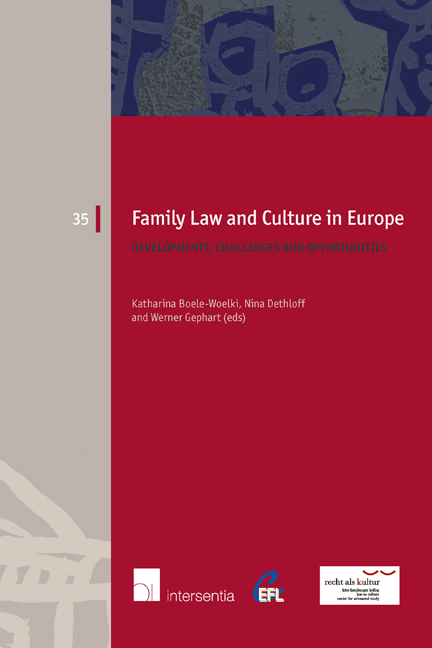Book contents
- Frontmatter
- Preface
- Contents
- List of Authors
- PART ONE THE CEFL PRINCIPLES ON PROPERTY RELATIONS BETWEEN SPOUSES
- PART TWO BREAKUP OF (NON-)FORMALISED RELATIONSHIPS
- PART THREE NEW CONCEPTS OF PARENTAGE
- The Right of the Child to Parents
- Contracting on Parentage
- Biological and Social Parenthood
- France: Biological and Social Parentage
- Anonymous Relinquishment and Baby-Boxes: Life-Saving Mechanisms or a Violation of Human Rights?
- Cross-Border Surrogacy: Time for a Convention?
- Re-Thinking Family Law: A New Legal Paradigm for Stepfamilies?
- PART FOUR INTERNATIONAL FAMILY RELATIONSHIPS
- PART FIVE TRANSNATIONAL FAMILIES: ACROSS NATIONS AND CULTURES
- EUROPEAN FAMILY LAW SERIES
Cross-Border Surrogacy: Time for a Convention?
from PART THREE - NEW CONCEPTS OF PARENTAGE
Published online by Cambridge University Press: 22 November 2017
- Frontmatter
- Preface
- Contents
- List of Authors
- PART ONE THE CEFL PRINCIPLES ON PROPERTY RELATIONS BETWEEN SPOUSES
- PART TWO BREAKUP OF (NON-)FORMALISED RELATIONSHIPS
- PART THREE NEW CONCEPTS OF PARENTAGE
- The Right of the Child to Parents
- Contracting on Parentage
- Biological and Social Parenthood
- France: Biological and Social Parentage
- Anonymous Relinquishment and Baby-Boxes: Life-Saving Mechanisms or a Violation of Human Rights?
- Cross-Border Surrogacy: Time for a Convention?
- Re-Thinking Family Law: A New Legal Paradigm for Stepfamilies?
- PART FOUR INTERNATIONAL FAMILY RELATIONSHIPS
- PART FIVE TRANSNATIONAL FAMILIES: ACROSS NATIONS AND CULTURES
- EUROPEAN FAMILY LAW SERIES
Summary
As the law of parentage is striving to meet the challenges of new reproductive technologies, dealing with cross-border surrogacies emerges as one of the most pressing topics in international family law. The current legal situation as regards surrogacy is quite diverse – throughout the world but also within Europe. Legal diversity has recently made a lot of people engage in so-called ‘procreative tourism’: coming from a country with a rather strict approach, they commission women in one of the more liberal countries to bear a child for them, and once the baby is born, they try to take it to their home country, thereby obviating the surrogacy ban that prevents them from entrusting a surrogate mother at home. European courts struggle with a coherent approach on how to treat those citizens who have gone abroad to have a baby. Meanwhile, legal research and the Hague Conference on Private International Law are thinking about a convention in order to ease the cross-border recognition of surrogacy.
INTRODUCTION
With the growing technical possibilities of assisted reproduction, the once monolithic idea of parenthood falls to pieces. Motherhood in particular splits up into genetic, gestational, and social motherhood – three roles that, once bound together, can now be taken over by two or even three different women. An increasingly popular and socially somewhat accepted model involving multiple mothers for one child is surrogacy: a surrogate mother commits herself to carry an embryo for another woman who for reasons of reluctance, age or medical conditions cannot or does not want to do so. Usually, one of the intended parents gives his sperm for the fertilisation of an egg that may stem either from the surrogate mother herself (traditional surrogacy) or from the intended mother or an egg donor (gestational surrogacy).
While surrogacy has been technically feasible for decades, it has only recently become a thriving business and thereby a notable case driver for European courts. Between 2006 and 2010, figures have increased nearly tenfold, meanwhile amounting to some small four-digit number of surrogacy cases involving intended parents from European countries every year. Most surrogacies take place in India, Ukraine, California, and Central America.
- Type
- Chapter
- Information
- Family Law and Culture in EuropeDevelopments, Challenges and Opportunities, pp. 199 - 216Publisher: IntersentiaPrint publication year: 2014

